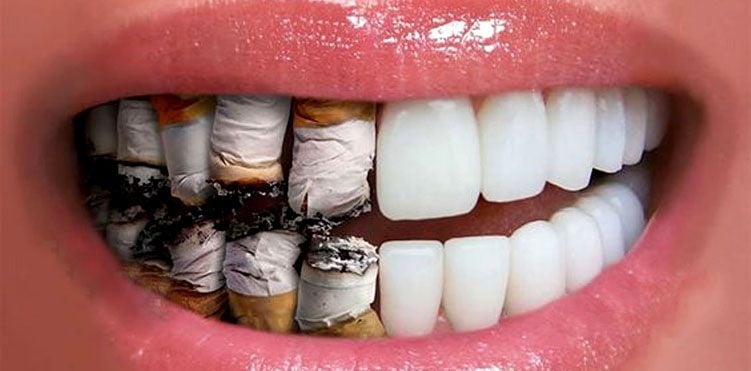How Does Smoking Lead to Gum Disease?
Smoking and other tobacco products can lead to gum disease by affecting the attachment of bone and soft tissue to your teeth. More specifically, it appears that smoking interferes with the normal function of gum tissue cells. This interference makes smokers more susceptible to infections, such as periodontal disease, and also seems to impair blood flow to the gums – which may affect wound healing.
Smoking leads to dental problems, including:
1. Creates plaque and tartar – Chemicals in tobacco products affect saliva flow in the mouth, making it easier for oral bacteria to stick to teeth and gums. Filmy, bacteria-laden plaque can develop on teeth and along the gum line. If not removed daily, it can harden into tartar, also known as calculus, a substance so hard it requires a professional cleaning to remove. Smokers are three to six times more likely to develop gum disease or periodontal disease, which can attack roots and cause teeth to fall out.
Even smokeless tobacco products can irritate gum tissue, causing gums to loosen around teeth, making it easier for bacteria to settle in and develop decay.
2. Interferes with blood circulation – Smoking affects the normal function of gum tissue, causing infections and restricting blood flow. It also delays healing after oral surgery for dental implants, tooth extraction or treatment of gum disease. This makes the recovery process difficult. When brushing or flossing, smokers may notice that their gums bleed easily.
3. Leads to oral cancer – According to WebMD, about 90 percent of people diagnosed with cancer of the mouth, throat or lips used tobacco. Smokers are six times more likely than nonsmokers to develop oral cancers.
4. Changes teeth and breath – Smoking can stain teeth to a yellow color and also cause bad breath.
How Is Smoking Related to Gum Disease?
- Red or swollen gums
- Tender or bleeding gums
- Painful chewing
- Loose teeth
- Sensitive teeth
- Gums that have pulled away from your teeth
You can help avoid gum disease with good dental habits
- Brush your teeth twice a day.
- Floss often to remove plaque.
- See a dentist regularly for checkups and professional cleanings.
- Don’t smoke. If you smoke, quit.
Regular cleanings at your dentist’s office and daily brushing and flossing can help treat early gum disease (gingivitis).
More severe gum disease may require:
- Deep cleaning below the gum line.
- Prescription mouth rinse or medicine.
- Surgery to remove tartar deep under the gums.
- Surgery to help heal bone or gums lost to periodontitis. Your dentist may use small bits of bone to fill places where bone has been lost. Or your dentist may move tissue from one place in your mouth to cover exposed tooth roots.
- If you smoke or use spit tobacco, quitting will help your gums heal after treatment.
Kick the Tobacco Habit
Regardless of how long you have used tobacco products, quitting now can greatly reduce serious risks to your health. Eleven years after quitting, former smokers’ likelihood of having periodontal (gum) disease was not significantly different from people who never smoked.
Even reducing the amount you smoke appears to help. One study found that smokers who reduced their smoking habit to less than half a pack a day had only three times the risk of developing gum disease compared with nonsmokers, which was significantly lower than the six times higher risk seen in those who smoked more than a pack and a half per day.
Treatment solutions
If you smoke or use tobacco products, reduce the risk of oral health problems by brushing twice daily, after breakfast and before bedtime, and floss once each day.
- Schedule regular appointments, as directed by your dentist, for professional teeth cleanings and checkups.
- quit smoking or at least cut down.





